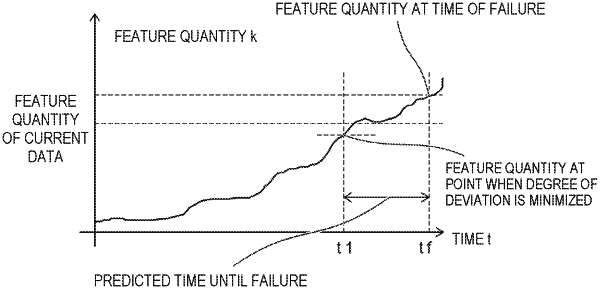| CPC H01L 21/67276 (2013.01) [C25D 3/12 (2013.01); G05B 19/058 (2013.01); G05B 19/41875 (2013.01); G05B 23/02 (2013.01); G05B 23/0283 (2013.01); H01L 21/67057 (2013.01); H01L 21/67086 (2013.01); H01L 21/67242 (2013.01); H01L 21/67288 (2013.01); H01L 21/67751 (2013.01); H01L 21/68707 (2013.01); C25D 17/001 (2013.01); C25D 17/02 (2013.01); C25D 17/10 (2013.01); C25D 21/06 (2013.01); C25D 21/10 (2013.01); C25D 21/12 (2013.01); G05B 2219/2602 (2013.01)] | 10 Claims |

|
1. A semiconductor manufacturing apparatus for processing substrates, comprising:
a first device which is a component among a plurality of components of the semiconductor manufacturing apparatus;
a first calculating circuit that determines one or more measured feature quantities indicating a state of the first device based on one or more physical quantities indicating the state of the first device detected at the first device, each measured feature quantity being set to a value based on each corresponding physical quantity among the one or more physical quantities;
an abnormal detection circuit that determines whether the first device is operating normally or abnormally by evaluating the one or more measured feature quantities by an identifier generated by learning with a support vector machine, using as training samples a normal data set of feature quantities representative of normal operation and a failure data set of feature quantities representative of abnormal operation, or by evaluating the measured one or more feature quantities based on a degree of deviation of the measured one or more feature quantities from the normal data set; and
a failure prediction circuit that:
calculates, when the first device is determined to be operating abnormally, a deviation between a measured feature quantities vector comprising the measured one or more feature quantities and one or more model feature quantities vectors, wherein each of the one or more model feature quantities vectors comprises one or more model feature quantities corresponding to the measured feature quantities and the calculation is performed at each time in a plurality of pieces of model data, wherein each piece of model data includes a temporal change in corresponding one or more model feature quantities in the model feature quantities vector, until the first device fails from a normal state of the first device,
determines one or more pieces of model data included in the one or more model feature quantities vector with a minimum deviation between the measured feature quantities vector and the model feature quantities vector at each time in the plurality of pieces of model data, among the plurality of pieces of model data,
calculates one or more predicted times until failure from one or more differences between a failure time point in the determined one or more pieces of model data and one or more points in time corresponding to the one or more model feature quantities that is obtained based on the one or more measured feature quantities which causes the abnormal detection circuit to determine that the first device is operating, the minimum predicted time is selected from among the plurality of predicted times, and
stops the receiving of a new substrate to prevent an introduction of defects on the new substrate when the minimum predicted time until failure is smaller than a predetermined threshold.
|